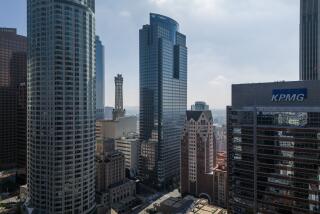San Francisco’s 58-story Millennium Tower is upscale, but literally sinking fast
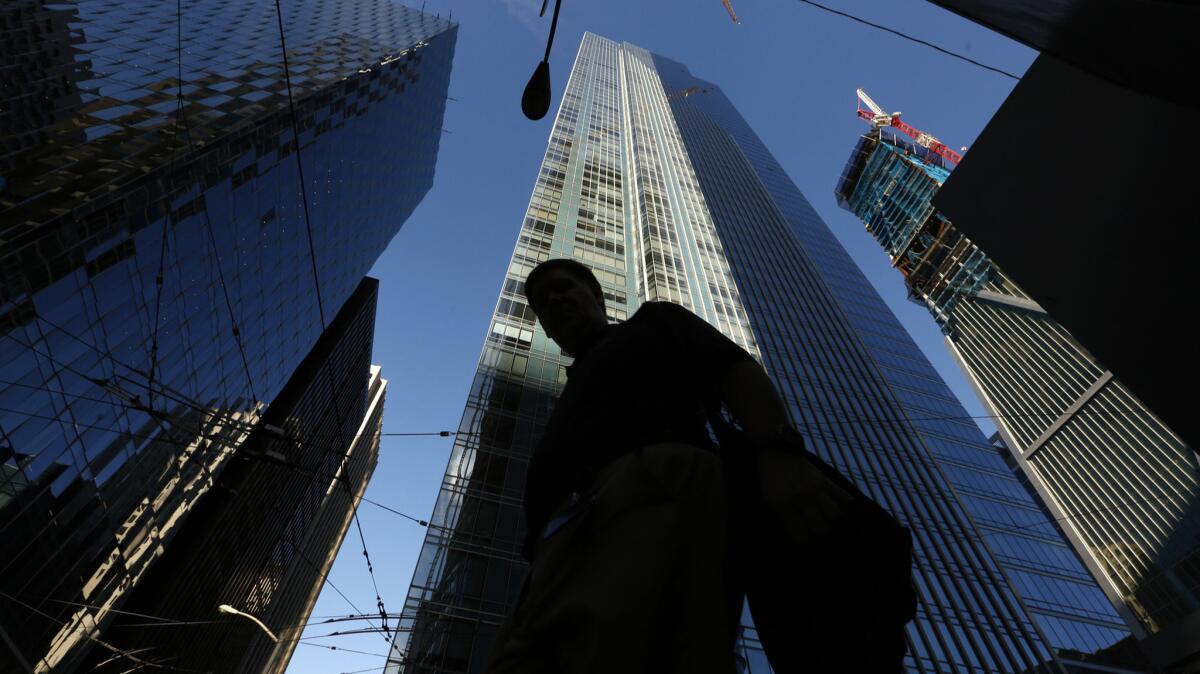
- Share via
Reporting from SAN FRANCISCO — Looking back, Pamela Buttery can recall an early clue that something could be amiss at the luxury high-rise where she’s lived for the past six years.
A golfer, she sometimes practiced her putting indoors, tapping the ball toward a portable cup on the hardwood floor in her living room.
If Buttery missed, the ball would carom off the wall and strangely change course, swerving right and gaining momentum as it rolled toward the northwest corner of her condo. At which point, she said, her cat Maximus would “go racing after the ball.”
It became a game between them, but it also presaged what in the past several months has become a sobering reality for the retired real estate developer and other residents of the 58-story Millennium Tower:
The tower is sinking — 16 inches so far, with projections that the amount could double over time.
Friendships we had have been broken by this, and other friendships we didn’t have before have been born.
— Jerry Dodson, resident of Millennium Towers
And as it sinks, the building also has begun to list ever so slightly — an estimated two to four inches at the structure’s base and 14 inches at the top, where Buttery’s unit sits at the northwest corner of the next-to-highest floor.
“The more it sinks unevenly, the more it is going to tilt,” Buttery has been told.
Is she nervous?
“I am not so much nervous as I am distressed,” the 76-year-old London native said. “This is not going to be fixed in my lifetime, and it is distressing to not know where I am going to live, and die, basically.”
::
The story of the sinking tower broke in early August, with a front-page report in the San Francisco Chronicle. Since then, it has been a news staple, playing out along a number of narrative plot lines — an engineering whodunit, a slow-motion real estate calamity, and also a civic cautionary tale.
This is not going to be fixed in my lifetime, and it is distressing to not know where I am going to live, and die, basically.
— Pamela Buttery, Millennium Tower resident
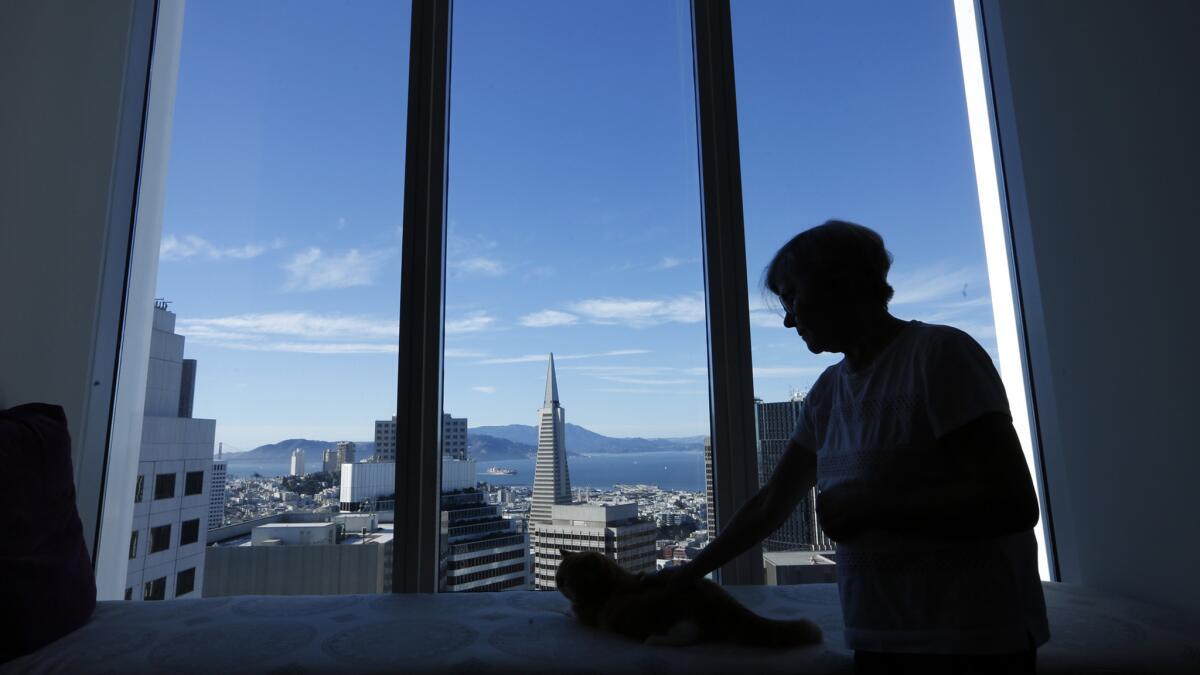
Fueled by a high tech boom and a resultant runaway real estate market — and following the removal of a double-deck highway that ran along the waterfront but was badly damaged by the 1989 Loma Prieta earthquake — a forest of towers has been rising up in San Francisco, especially in the downtown district known as South of Market.
“As you know,” Sen. Dianne Feinstein (D-Calif.), a former mayor of the city, wrote in August to current Mayor Ed Lee, “I have had great concern, generally, with the recent residential and commercial density increase in San Francisco, as well as concern about the City’s preparedness for a large scale seismic event.
“Now, to add to that mix of concern, I am left wondering if the City’s building code played any role in allowing this sinking and tilting to happen, and whether or not other approved buildings are suffering the same fate.”
While a paper trail of concern about potential settling leads back to early 2009, even before the Millennium Tower was ready for occupancy, most residents of the building knew nothing about any issue with the foundation until they were summoned in early May to a private meeting in a lounge on the tower’s club level.
Identification was checked at the door. Residents were told that what they were to hear must be kept a secret. A lawyer introduced a structural engineer who delivered, as Buttery and others recall, a simple statement that startled the packed room:
“The Millennium building is too heavy for its foundation.”
Not only had the tower settled by far more than the four to six inches originally forecast for the life of the building but, “most importantly,” recalled Jerry Dodson, a retired patent lawyer and a vocal critic of the tower’s builders, the engineer said “it wasn’t stopping.”
Dodson has since heard estimates that the building could sink anywhere from 30 to 48 inches, “but nobody really knows.”
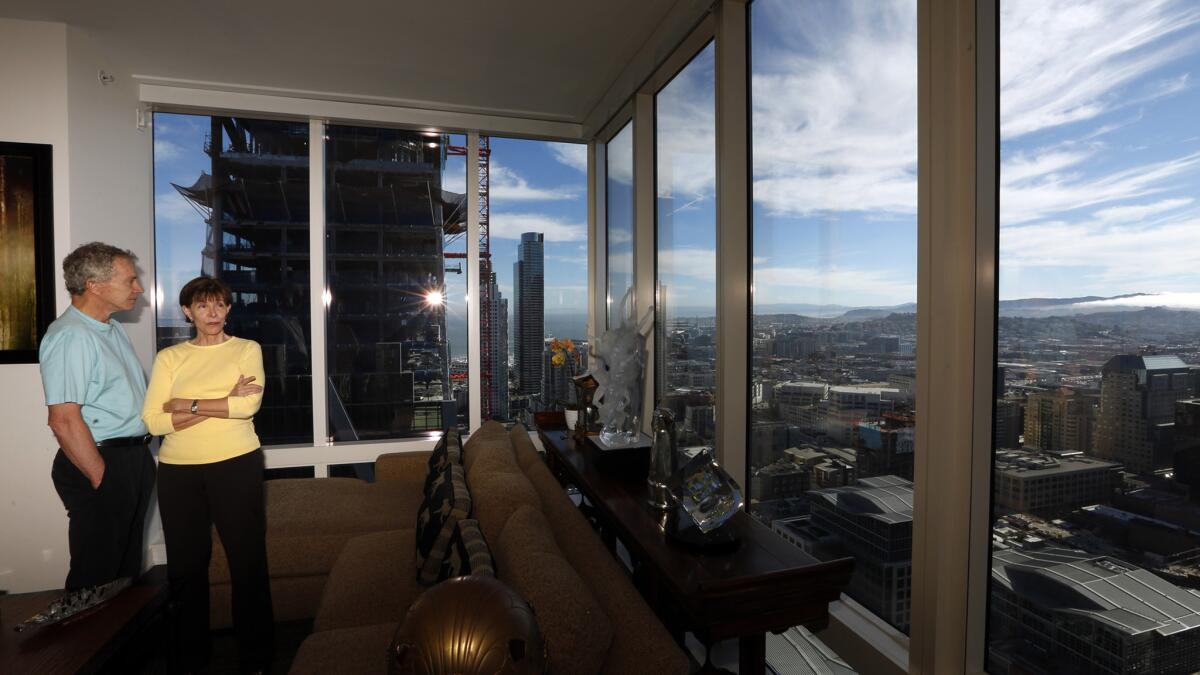
Condo owner Paula Pretlow, a retired financial advisor, was at the meeting. She had watched for years from a nearby office as the tower rose, floor by floor, from a pit in the ground to become a gleaming edifice of concrete and glass — said to be the heaviest high-rise west of the Mississippi.
The tower was being erected on landfill that previously was part of the bay — like much of the eastern flank of the San Francisco Peninsula, and as a prospective buyer, Pretlow took hardhat tours of the building in progress, asking what she thought were all the right questions about the construction quality and safety.
In September, 2010, Pretlow moved in, one of the first occupants on her floor. She leased at first, and then sold her suburban home and purchased the unit outright.
“Never, ever would I have plunked down money in that building had I been given any hint something was wrong,” she said. “I was not told the whole truth, and to me that is the same as being lied to.”
The timing of the May disclosure was particularly harsh in Pretlow’s case. The chaos of constant, industrial-scale construction in the surrounding neighborhood had convinced her the time had come to sell her unit and move somewhere more serene. She had lined up a real estate agent with the intent of listing her condo in June.
Then came the May meeting.
I am left wondering if the City’s building code played any role in allowing this sinking and tilting to happen...and whether other buildings are suffering...
— Sen. Dianne Feinstein, former San Francisco mayor
“I felt anger. I felt that I had been duped,” Pretlow said. “And I also had a feeling that I should have got out a year ago. I felt, I am stuck, how many years longer am I going to be stuck in this building?”
Dodson and several other condo owners in the tower blame Millennium Partners, the tower builders, for not driving foundational piles 200 feet to bedrock, as was done with a 61-story skyscraper going up across the street. Instead, the builders relied on a concrete foundation attached to piles that were sunk into firmly compacted sand and mud about 60 to 90 feet below.
Such foundations are not uncommon in San Francisco, even on land fill — although many of the buildings so anchored are constructed with lighter, steel frames.
Millennium Partners, in turn, blames a massive construction project underway adjacent to the tower.
In preparing to build a multi-agency transit center for rail and bus, the tower builders maintain, the Transbay Joint Powers Authority has lowered the underground water table beneath the tower, causing settlement.
Millennium Partners and the Transbay authority disagree with equal vigor.
There’s a lot of history for me here, good and bad.
— Helena Geng, Millennium Tower resident
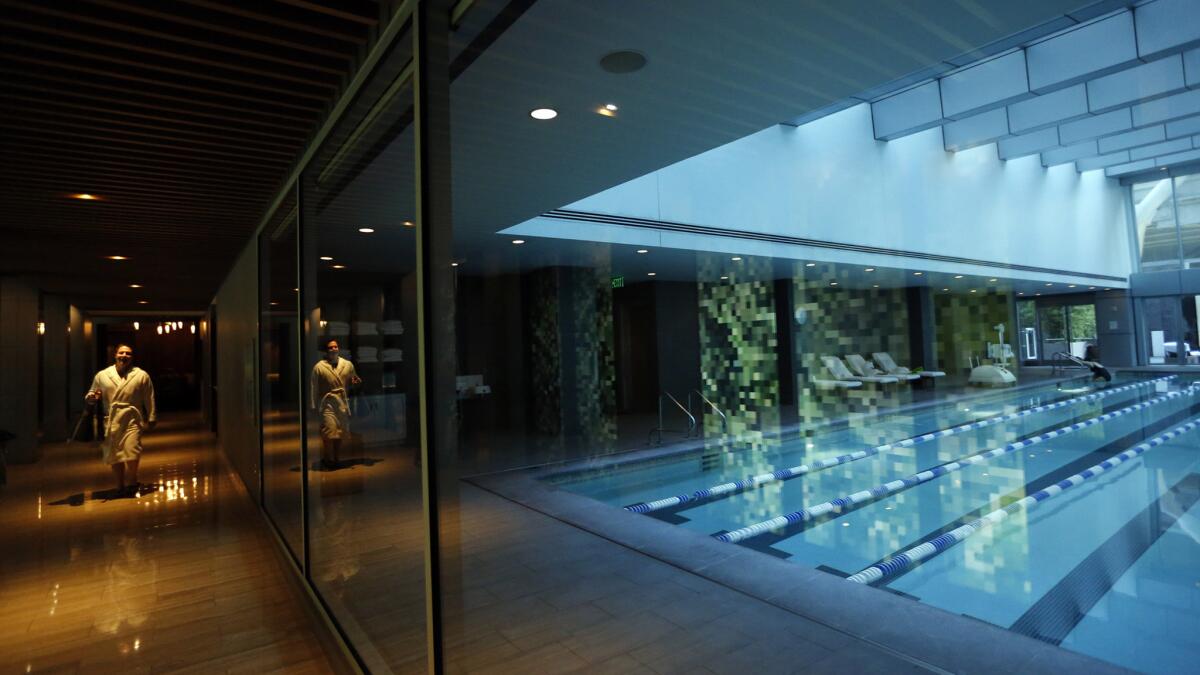
High-rise construction projects also create piles of paper work, and since the disclosure no shortage of conflicting engineer studies and internal documents have come to light. And even more geological surveys are in the works.
Needless to say, the lawyers are circling.
::
The initial headlines described Millennium Tower as a building for the “rich and famous.” And, yes, professional sports stars and high tech heavy hitters — Joe Montana, the former 49ers quarterback, the late venture capitalist Thomas Perkins — have called it home. And, yes, the cars brought forward by the building valets trend toward Range Rovers and Teslas and Audis.
But there are also long-time suburban homeowners, like Pretlow, who sold in an infamously inflated market and invested in tower living.
“You hear about the rich and famous,” said Helena Geng, an immigrant from China who moved into the tower with her husband in 2011, “but to us, this was a large chunk of our money.”
Geng’s connection to the building is bittersweet. Her 4-year-old twins have lived there since birth. Her husband died there while working out in the tower gym, which is one of the building’s much-touted amenities.
“That is why I would have a hard time leaving,” she said at a patio table outside the second floor. “There’s a lot of history for me here, good and bad.”
Like several other residents interviewed, Geng spoke glowingly of life in the tower. She described it as a “vertical neighborhood,” where neighbors get to know one another well, gather for special events in the lounge, and at Halloween hand out candy to youngsters who live in the tower.
The sinking, though, has taken its toll. Geng and others speak of sleep interrupted by worry, panicky thoughts about earthquakes, red tags from building inspectors and the prospect of remaining stuck in a real estate abyss.
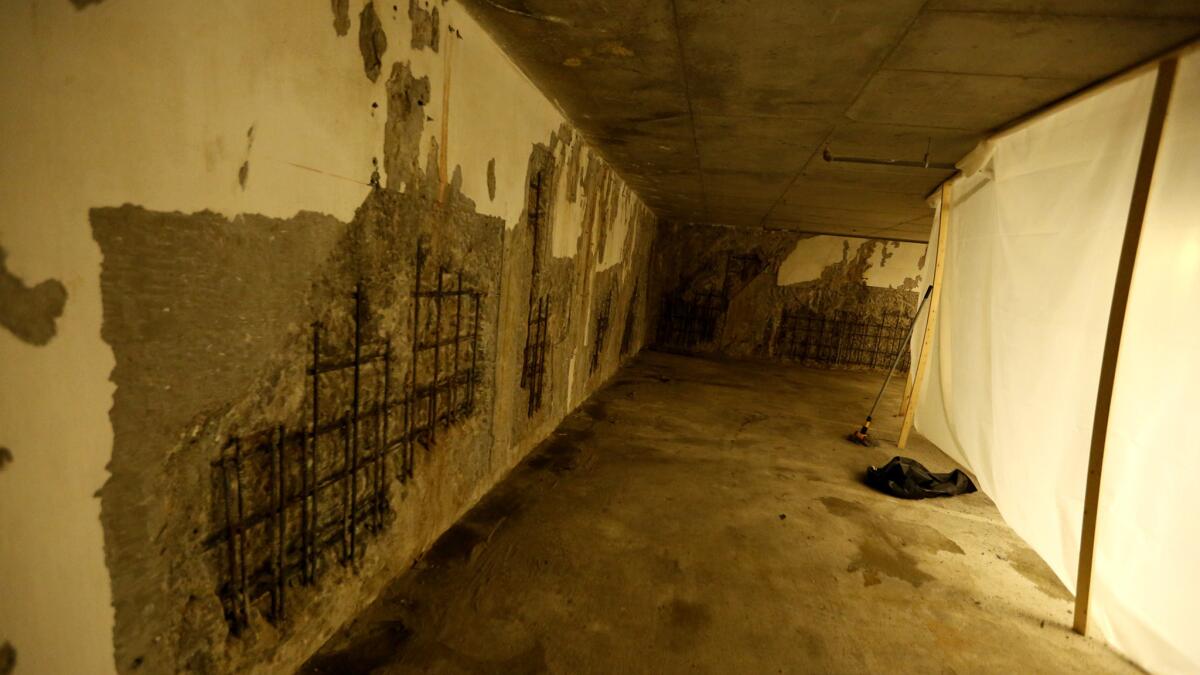
They circulate photos of the many cracks visible in the basement’s concrete walls, and wonder what they might portend. Some feel themselves tense up after they return to the tower after a few days away.
And while safe for occupancy now, there are concerns among some residents about potential threats to the tower’s high-speed elevators and sewer connections should the sinking continue — or should a significant seismic event occur.
“The building could go from safe to unsafe in a day,” said Dodson, who lives with his wife, Pat, on the 47th floor.
The situation has created factions within the vertical neighborhood. There are those who would have preferred quiet negotiations with Millennium Partners, rather than endless media coverage. And there are those who want to take on the big players — Millennium Partners, the Transbay authority, both — legal guns ablaze.
“Friendships we had have been broken by this,” Dodson said, “and other friendships we didn’t have before have been born.”
While one unit has sold since the sinking went public, the buyer was someone who already owned in the building. And most condo owners fear their units would fetch prices far below what they paid.
Buttery, who bought her high-ceilinged condo for $3.5 million, was one of scores of tower residents who have made their way to the tax assessor’s office, seeking to re-adjust the appraised worth of their units.
Filling out the assessment form, she put down that her unit should now be valued at zero.
“The clerk said, ‘You can’t put down just zero.”
“I said, ‘OK.’
“And I put down one dollar.”
Tower residents worry about being abandoned by the city, left to fend for themselves when it comes to paying for a fix — if there is one. The possible solutions in play so far seem to border on fantasy.
“One prominent architect suggested that you might have to lop 20 stories off the top of the 58-story building to make it light enough so that it will stop descending into the landfill,” former Mayor Willie Brown wrote in his weekly Chronicle column. “Another suggested to me that they might have to take the whole building apart and put it back together with a new foundation.
“And they were both serious.”
Even worse than a drastic solution would be no solution at all: “Yes,” a Millennium Partners spokesperson replied in an e-mail, citing a recent seismic study, “it is quite possible that no major fixes will be required.”
Geng recoiled at the suggestion: “No, I do not accept that. With a sinking and leaning building, and without doing anything to the foundation … ? No, that is unacceptable.”
A MIT-educated engineer by training, and a real estate broker by trade, Geng believes a solution can be found that would both shore up the building and also remove its marketplace stigma.
“This is a physics problem,” she said. “It can be solved.”
She also expressed a belief that eventually both Millennium Partners and the city will do right by the tower residents.
“I’m an eternal optimist,” she said finally, as she rose to leave and pick up her twins from school.
Later, Geng sent along a clarifying email to her interviewer: “I know I said I was an eternal optimist…. However, I don’t want this statement to lighten the blame in any way, shape or form on what MP has done so far, and how the city has contributed to our predicament….”
The email arrived at 2:53 a.m.
One more sleepless night in the sinking tower.
ALSO
Campaign retracts Leonardo DiCaprio’s endorsement of anti-development measure
Surfers take to sometimes-tainted water in the name of science
Weather reports, but for earthquakes: Why you should pay attention during the next seismic forecast
More to Read
Sign up for Essential California
The most important California stories and recommendations in your inbox every morning.
You may occasionally receive promotional content from the Los Angeles Times.


